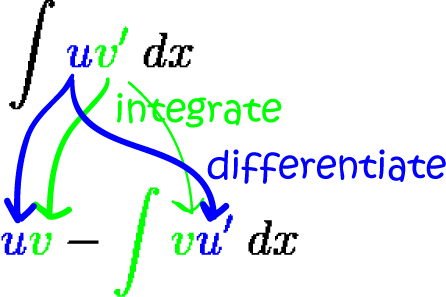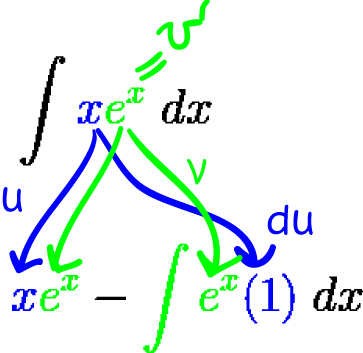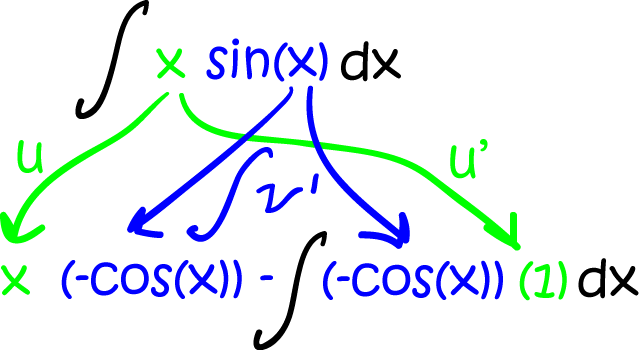Calculus
Chapters
How Do We Find Integrals of Products?
How Do We Find Integrals of Products?
We've seen that we have to be careful when taking derivatives of products: you can't just take the product of the derivatives. You have to use the product rule instead:
integration by parts formula:

Example 1
Find \(\displaystyle{\int xe^x \;dx}\)
First, we need to choose one function to differentiate (\(u\)) and another one to integrate (\(v'\)).
Let's try setting \(u = x\) and \(v' = e^x\)
Now our integral is in the form
- Differentiate \(u\): \(u' = 1\)
- Integrate \(v'\): \(v = \displaystyle{\int e^x\; dx} = e^x\)

- Choose \(u\) and \(v'\) (one to differentiate and the other to integrate)
- Differentiate \(u\) to give \(u'\)
- Integrate \(v'\) to give \(v\)
- Plug them into the formula: \(\displaystyle{\int uv'\;dx = uv - \int vu'\; dx.}\)
- Simplify and integrate.
Let's try some more examples.
Example 2
Find \(\displaystyle{\int x\sin x \;dx}\)
First we need to choose one function to differentiate (\(u\)) and another one to integrate (\(v'\)).
Let's try setting \(u = x\) and \(v' = \sin x\)
Now our integral is in the form
- Differentiate \(u\): \(u' = 1\)
- Integrate \(v'\): \(v = \int \sin x\; dx = - \cos x\)

Choosing \(u\) and \(v'\)
You might have noticed in the last two examples that the expressions we chose for \(u\) and \(v'\) actually made the integral simpler once we'd applied the integration by parts formula. Most of the time, this is exactly what we try to do: make our lives easier. We try choose a function for \(u\) that will get simpler as we differentiate it, and a function for \(v'\) that is easy to integrate.
Let's have a look at how things can go horribly wrong if we choose \(u\) and \(v'\) badly.
Example 3
What is \(\displaystyle{\int x\cos (x) \;dx}\)First, we need to choose one function to differentiate (\(u\)) and another one to integrate (\(v'\)).
Let's try setting \(u = \cos (x)\) and \(v' = x\)
Now our integral is in the form
- Differentiate \(u\): \(u' = -\sin (x)\)
- Integrate \(v'\): \(v = \displaystyle{\int x\; dx }= \dfrac{x^2}{2}\)
Let's try doing it the right way: set \(u = x\) and \(v' = \cos x\).
- Differentiate \(u\): \(u' = 1\)
- Integrate \(v'\): \(v = \int \cos(x)\; dx = \sin x\)
So, most of the time, we need to choose a \(u\) that gets simpler when you differentiate it, and a \(v'\) that is easy to integrate, or at least doesn't become any more complicated when you integrate it. Sometimes, however, we need to use some cunning tricks! Let's look at an example.
Example 4
Find \(\displaystyle{\int \ln(x)\;dx}\)
At first glance, this doesn't even look like there's a product anywhere in sight. But there's a \(1\) hiding:
- Differentiate \(u\): \(u' = \dfrac{1}{x}\)
- Integrate \(v'\): \(v = \displaystyle{ \int (1)\; dx} = x\)
Using Integration by Parts More Than Once
If our integrand (the thing we're integrating) involves a power of \(x\) such as \(x^2\) or \(x^3\), we might need to use integration by parts more than once to evaluate our integral. Remember, make sure all your \(u\)s and \(v'\)s come from the same place. If you start interchanging them, you'll start going around in circles.
Example 5
Find \(\displaystyle{\int x^2 e^x \; dx}\)
We want our \(u\)s to get simpler as we differentiate them, and our \(v'\)s not to get any more complicated, so we choose \(u = x^2\) and \(v' = e^x\). Next,
- Differentiate \(u\): \(u' = 2x\)
- Integrate \(v'\): \(v = \displaystyle{\int e^x\; dx} = e^x\)
- Differentiate \(u\): \(u' = 1\)
- Integrate \(v'\): \(v = \int e^x\; dx = e^x\)
One Last Integration Party Trick (sometimes it's OK to go around in circles)
Let's try to find \(\displaystyle{\int e^x \cos(x) \; dx}\)
It's a product, so integration by parts sounds like a good idea. Choose your weapons:
- Set \(u = \cos(x)\)
- Set \(v' = e^x\)
- Differentiate \(u\): \(u' = -\sin (x)\)
- Integrate \(v'\): \(v = \displaystyle{\int e^x\; dx} = e^x\)
- Differentiate \(u\): \(u' = \cos (x)\)
- Integrate \(v'\): \(v = \displaystyle{\int e^x\; dx} = e^x\)
Now's the time to get plenty of practice. Don't worry, it takes a bit of getting used to, but integration by parts will soon become your new best friend. Mathematics is definitely not a spectator sport!
Description
Calculus is the branch of mathematics that deals with the finding and properties of derivatives and integrals of functions, by methods originally based on the summation of infinitesimal differences. The two main types are differential calculus and integral calculus.
Environment
It is considered a good practice to take notes and revise what you learnt and practice it.
Audience
Grade 9+ Students
Learning Objectives
Familiarize yourself with Calculus topics such as Limits, Functions, Differentiability etc
Author: Subject Coach
Added on: 23rd Nov 2017
You must be logged in as Student to ask a Question.
None just yet!